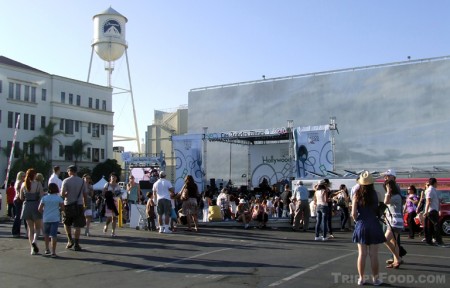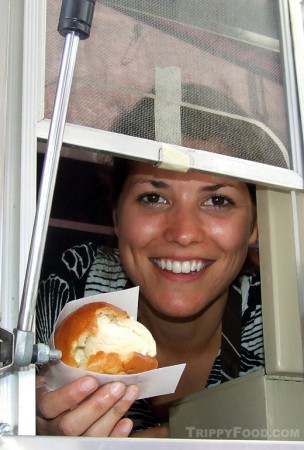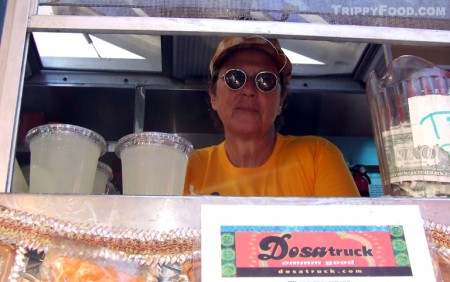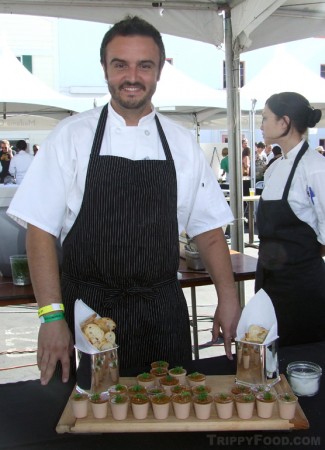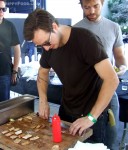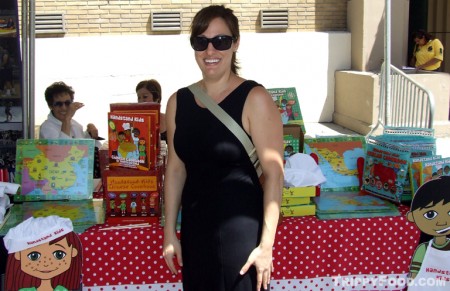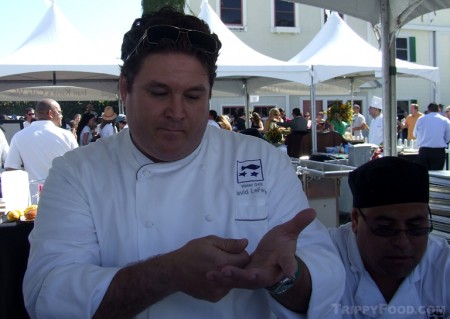LA Times Celebration of Food and Wine
Paramount Pictures backlot, Hollywood, California
If you’ve been reading Los Angeles food blogs, you’ve already heard what the recent inaugural LA Times Celebration of Food and Wine was not. What it was not was a free lunch, as your $55 General Admission ticket got you onto the historic Paramount Pictures Studios backlot, some free sample tidbits, a seat at the cooking demonstrations and panels with chefs, food truck owners and foodies and concert performances by Angela McKluskey and She and Him. The complaint was that you were still required to purchase food from some of the vendors providing more substantial food (as well as the offerings of the fleet of food trucks parked along the fake streets). Well, as the old saying goes, you gotta make your own fun, and if you put in a little effort you could walk away from the event satisfied. The wine flowed like wine for those with drink tickets and there were a plethora of vendors of a wide variety of other spirits including custom rum, sake, vodka and tequila but under the blistering Southern California sun I was sticking to the free bottles of water being handed out by Fiji. Stages were set up in various locations on the backlot; the Downtown Stage was used for cooking demonstrations, Westside Stage provided a forum for panel discussions, the LA Times Stage was used for question-and-answer sessions, a Wine Chat was held in the shell of one of the fake New York buildings and the Hollywood Stage was reserved for cooking demonstrations by Food Network and Cooking Channel rock stars and the concert performances. The staged events overlapped, meaning that if you aggressively planned to take in all demonstrations, panel discussions and concerts, you were going to miss something but it also meant that there was always something exciting going on. From a nostalgic standpoint, my favorite hangout was B Tank, a graduated pool holding close to a million gallons of water and used for aquatic scenes (such as the boat escape sequence in The Truman Show). Naturally, the pool was drained to make room for the Hollywood Stage, a dining area, and the food trucks participating in the Food Network’s Great Food Truck Race. Los Angeles was represented by the Ragin Cajun truck (complete with rented creole fiddling courtesy of Lisa Haley), Crepes Bonaparte, the Vietnamese-themed Nom Nom truck and Nana Queen’s Puddin’ and Wings.
The giant raspberry-adorned Cooking Channel truck was anchored at the end of the pool and was doling out free cups of salted caramel or strawberry buttermilk ice cream. It seemed odd that the Cooking Channel would have a food truck, but the way it works is that contest winners in various cities where the truck appears have the privilege of using the truck to provide samples of their products. In this case, the fresh, old-fashioned ice cream was made by Carmela, an ice cream manufacturer that normally sells at local farmers’ markets. Co-founded by Jessica Mortarotti in 2006 and named after her grandmother, Carmela takes fresh local ingredients and concocts well-loved flavors as well as the unusual (such as their heirloom tomato gelato or cucumber sorbet). The garden fruit flavors are not every day items, but I asked Jessica to let me know when the tomato dessert is available. TV chefs such as Darrel Smith, Roger Mooking and Aida Mollenkamp did basic cooking demonstrations on the big Hollywood Stage, but it was more fun to watch the demonstrations at the smaller Downtown Stage and queue up after the performance in hopes of getting to the food samples before the supply ran out. LA Times food editor Russ Parson hosted a discussion and demonstration of farm-to-table cooking featuring Campanile/The Tar Pit’s Mark Peel and Suzanne Goin of AOC, Lucques and Tavern; LaVarenne’s Anne Willan showed the crowd how to cook with peppers; and Easy Thai Cooking’s Tommy Tang presented easy Thai cooking (to the surprise of no one). My personal favorite was Noelle Carter (manager of the LA Times Test Kitchen) who grilled shrimp to perfection in a quick and easy performance that culminated in getting to sample the sweet and savory crustaceans on a stick.
While Carmela dished out free ice cream, Coolhaus’ ice cream truck was on hand with their signature ice cream sandwiches for sale. Natasha Case started what has turned into a mini-fleet with co-founder Freya Estreller in April of 2009. For her vehicle of choice she chose a small US Postal Service mail van and had it retrofitted for keeping the dairy confections cold by a place she referred to as “Junior’s” in nearby City of Industry. Coolhaus currently has 2 trucks, but by November they will have 4 (with one giving Amy’s Ice Cream a run for their money in Austin, Texas). The concept is simple – select an ice cream flavor and your choice of cookie to sandwich it. The concoction is then handed to you in a potato starch wrapper with Coolhaus’ logo that Willy Wonka would be proud of, as it is also edible (Catholics will appreciate that the taste and texture of the wrapper is similar to communion wafer). I debated between the Guinness chip, the balsamic fig and mascarpone, the pistachio black truffle and the brown butter and candied bacon, but ultimately the victor was the trippiest flavor I’d ever come across – foie gras. There was no way this was getting surrounded by a chocolate chip cookie; fortunately they offered a moist, rich brioche that complemented the goose liver well. As with garlic ice cream, the initial flavor is sweet cream, but once the aroma sneaks up the back of your nose and hits the olfactory sensors, the ultra-rich taste of the foie gras creeps in and is held at bay with the bready brioche. Instead of wiping my mouth with the wrapper, I found a perverse sense of satisfaction by stuffing it in.
Another food truck that fascinated me, yet I admittedly had not encountered before was the Dosa Truck. Think vegetarian crepe, moo shu or burrito and you get an idea of the Indian street food offered on self-titled dosa waller Leena Deneroff’s truck is like. Everything is made from scratch, including the urad dal (the labor-intensive batter used for “throwing” the dosa). The dosa is the thin, pancake-like wrap used to contain all that vegetarian goodness; the batter can take up to several days to make as it involves soaking, grinding and fermenting black-shelled urad beans. The timing has to be perfect, and in order to ensure enough batter each day batches are staggered days in advanced. I asked Leena what would prompt someone to specialize in a food that requires so much time and effort to produce, and she simply stated, “I love it!”; Deneroff has been enjoying dosa for over 20 years and wanted to share her love of the food with others. The truck has been on the streets since July of 2009 and business is steadily improving. The most popular item is the Slumdog (a dosa coated with a pesto-like paste and stuffed with paneer, fresh spinach and curried potatoes), but I wanted to try the most traditional item, the Mumbai Madness. This is the closest thing the dosa you would get directly off of a street cart in Mumbai, filled with nothing but warm, tender curried potato. The dosa has a slightly pungent taste, but inoffensive; while still somewhat doughy it gets crispy along the end which adds wonderful texture to the dish, and the potatoes were not too mushy or too firm. Deneroff participated in a panel discussion with Natasha Case and Jennifer Green from the Nom Nom Truck, which to me was one of the highlights of the festival. Other panels included bloggers Ree Drummond (The Pioneer Woman) and Aarti Sequeira (Aarti Paarti) who encouraged would-be food bloggers; Life After Top Chef featuring former contestants Betty Fraser, Chris Jacobsen and Alex Reznik; Re-inventing Latin Cuisine with Jimmy Shaw (Loteria Grill), Ricardo Zarate (Mo-Chica) and John Sedlar (Rivera); and, a panel titled “L.A.’s New Star Chefs” featuring Michael Voltaggio and John Shook and Vinny Dotolo of Animal. The last panel was like attending a rock concert; the chef groupies would erupt into maddening applause for their local heroes, but the chefs themselves seemed relatively down-to-earth. One thing that particularly impressed me about Chef Voltaggio was when he related a story of a schoolteacher that told him she and her husband saved up for 6 months to enjoy his cooking. This touched him in a way that made him vow to make fine cuisine accessible to everyone in a laid-back environment, and I hope he follows through on his goal and inspires others to do likewise.
My press credentials were a slightly more restrictive version of the general admission ticket, although I was granted access to the VIP area by escort. The VIP area was in a cordoned-off section of the main plaza across from Tank B and featured vendors providing free samples that weren’t represented at the rest of the festival; in addition there was a separate large tent where exclusive demonstrations and tastings were held. I was afraid my press pass was going to prove to be a detriment moving through the VIP area, but I discovered that as soon as the vendors saw the badge hanging from the lanyard I was dragged into booths to faster than a prospective john at Boy’s Town in Nuevo Laredo. My first “voulez vous mangez avec moi?” experience was at Water Grill’s booth. Executive Chef David LeFevre led a gang of oyster knife-wielding bad mothershuckers who were popping open Rappahannock River and Kumamoto oysters like nobody’s business. LeFevre explained that there are 5 main species of oysters (all of which he naturally could recite the scientific name for), with dozens, if not hundreds of sub-species. Water Grill features 8 of these sub-species at a time, meaning you could find two or three varieties from the same family that taste radically different. There are a number of factors that contribute to the distinctive flavor of an oyster, including water temperature, whether the oysters are exposed to air via tides, etc.; Chef LeFevre could describe to you what flavors would be present just by naming the oyster. I had never met anyone so well-versed in oysterology; he could tell a good oyster from a bad oyster by the look, sound and smell; mentioned the best places to source oysters and the worst (shockingly the Gulf Coast falls in the latter category due to susceptibility to red tide and other contaminants); demonstrated the way to perfectly and quickly shuck an oyster; and, explained how to keep oysters fresh and properly prepare and serve them. I tried one of the Rappahannocks that was freshly shucked; there were a variety of disguises available for the oysters (including lemon, horseradish, etc.) but I simply poured the mollusk into my mouth. The oyster was firm and briny without being overly salty – it tasted like the ocean and I could have easily eaten a dozen or more. One attendee tried an oyster for the first time in his life and grinned ear-to-ear when he found out how good they taste. Chef LeFevre mentioned that Water Grill features all kinds of seafood, prompting me to ask about New England seafood. Although they don’t do steamers (they don’t have an appreciative clientele), they do a lobster roll that doesn’t miss a step, right down to the squared-off hotdog bun.
Salt’s Cure also had a booth in the VIP area – they’ve only been opened 2 weeks, but are onboard the “nose-to-tail” train that seems to ensure popularity in the Los Angeles area. They shun the gastropub label, but pride themselves on making absolutely everything (right down to their in-house mayonnaise and ketchup). Everything is fresh and locally sourced; at the festival they were slicing pieces of smoked yellowtail snapper on toast with cucumbers and their own mayonnaise and each was a tiny explosion of flavor. Brendan Collins of Waterloo and City manned their booth which featured a chicken liver foie gras parfait with Madeira jelly in little plastic shot glasses. The foie gras was creamy with a whipped consistency with a thin layer of gelatin on top. W&C provided little round toast slices to scoop up the livery goo and a single taste was all that it took to slap me into shut-uppiness. The foie gras had a sharp and muted, earthy taste, but then the Madeira reduction kicked in and added a bold sweetness that offset yet complemented the flavor. I actually found myself breaking the cup apart and wresting the remaining dollops out with my tongue, an act I’m not particularly proud of yet offer no apology. They also presented a duck and walnut pate with orange marmalade, and it would appear that there isn’t an aspect of charcuterie Chef Collins hasn’t mastered. The man is like an offal pusher; he gets you hooked with your first little bites until you’re up at 4 AM wondering how long you’ll have to wait in Waterloo and City’s parking lot until they open.
One vendor in the general area that particularly impressed me was The Handstand Kids Cookbook Company. Yvette Garfield started the company in 2007 with the idea that children should be given options for expanding their food experience at an early age so that we don’t end up with a generation who consider Nissin Cup Noodles, Spaghetti-Os and Taco Bell smart ethnic food choices. Garfield has a target age of 6 to 10 years, although the cookbooks are accessible to kindergarten age kids up through young teens. There are three main cookbooks currently: Mexican (in a plastic “tortilla bag”), Italian (in a pizza box) and Chinese (in a big, red take-out box). The books introduce children to food terms in the language of the cuisine’s country of origin and then use the terms in the native tongue throughout. In addition to recipes with clear instruction, the books feature snippets of cultural stories and experiences as told from a kid’s point of view. In addition to the cookbooks, The Handstand Kids Cookbook Company also conducts Picky Eater Classes in single-day, hour-long segments and summer programs that range from 1 day per week to week-long workshops. Another booth listed as the Korean Cultural Center was handing out little samples of Noak Doo (a mung bean pancake) with a soy-based sauce for topping the tiny bites. The pancakes had a strong taste of fresh cabbage and onion, and although there was a grain-like quality to them they were made primarily from mung bean flour. To the left in the same booth sat a fleet of bottles of bokbunjajoo (black raspberry wine) and makegeolli rice beer for sale, but I couldn’t imagine when I’d have the opportunity to pair either of them with my meal.
Angela McCkuskey’s set sounded canned with live vocals, but it was slightly soulful and all pop; She & Him (featuring Zooey Deschanel & M. Ward) offered a folksy-pop set that was surprisingly good given the history of actors-turned-musicians we’ve been forced to endure. Unfortunately the terms of my media pass prohibited me from photographing She and Him’s performance, although it didn’t stop the audience from grabbing shots on their phones. From a standpoint of being a celebration of food and wine where you could experience, learn and participate in the culinary activities it was successful; hopefully they’ll work out a few of the logistics bugs before launching the second annual event. It would be nice to see a regular event that isn’t a celebration of food and whine.
Carmela
Los Angeles area farmers’ markets
Coolhaus
Los Angeles CA, Austin TX and NYC, NY
http://twitter.com/COOLHAUS
http://www.facebook.com/pages/COOLHAUS-Ice-Cream-Sandwiches/88028220134
Salt’s Cure
7494 Santa Monica Blvd.
West Hollywood, CA 90046
GPS Coordinates: 34°5’26.30″N 118°21’10.65″W
DOSAtruck
Los Angeles County, CA
http://twitter.com/dosatruck/
Water Grill
544 South Grand
Los Angeles, CA, 90071
GPS Coordinates: 34°2’55.89″N 118°15’17.76″W
Waterloo and City
12517 West Washington Blvd.
Culver City, CA 90066
GPS Coordinates: 33°59’49.06″N 118°25’53.27″W
GALLERY: See images from the inaugural LA Times Celebration of Food and Wine
Video from the inaugural LA Times Celebration of Food and Wine

